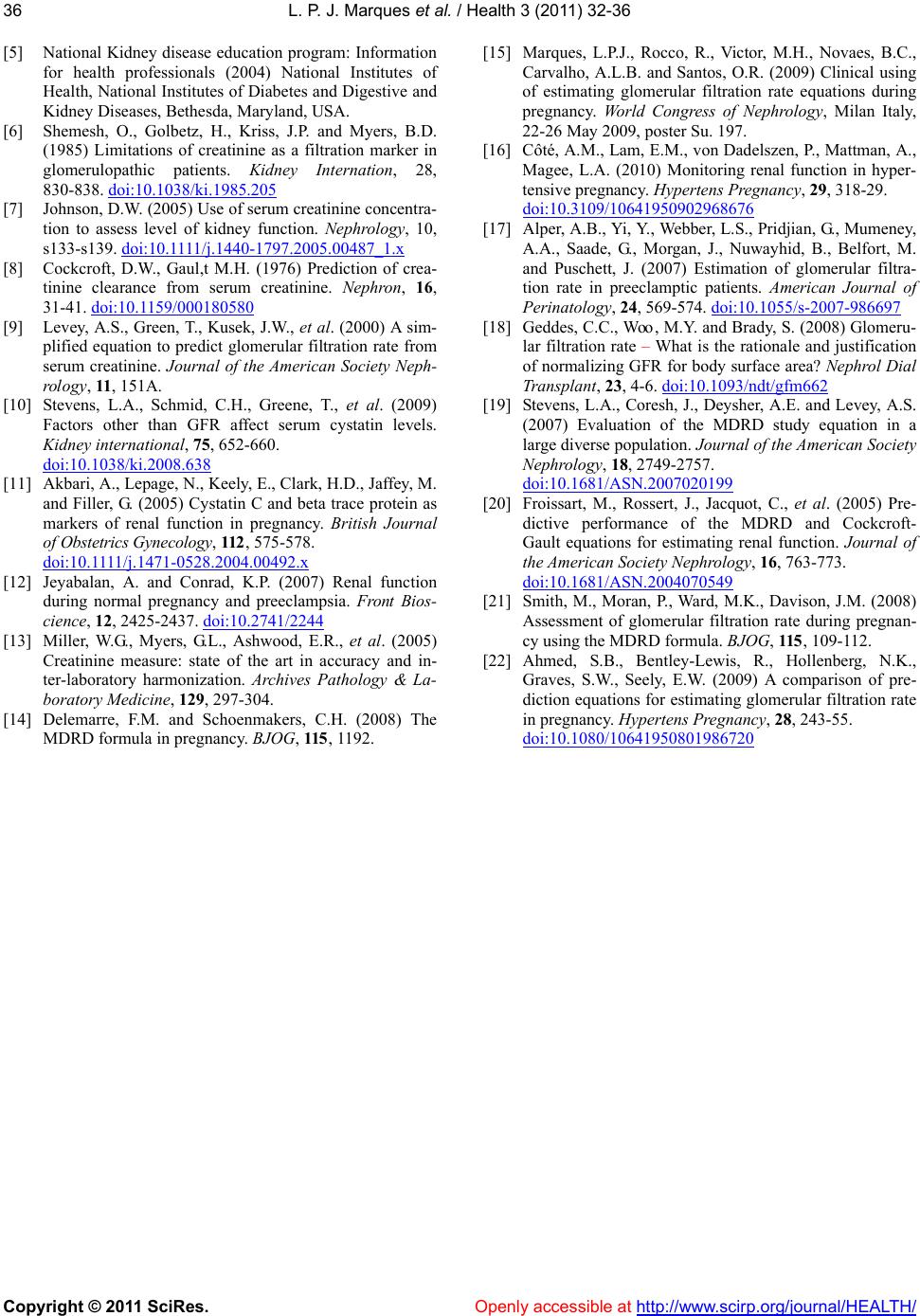
L. P. J. Marques et al. / Health 3 (2011) 32-36
Copyright © 2011 SciRes. Openly accessible at http://www.scirp.or g/journal/H E A LTH/
[5] National Kidney disease education program: Information
for health professionals (2004) National Institutes of
Health, National Institutes of Diabete s and Digestive and
Kidney Diseases, Bethesda, Maryland, USA.
[6] Shemesh, O., Golbetz, H., Kriss, J.P. and Myers , B.D.
(1985) Limitations of creatinine as a filtration marker in
glomerulopathic patients. Kidney Internation, 28,
830-838. doi:10.1038/ki.1985.205
[7] Johnson, D.W. (2005) Use of serum creatinine concentra-
tion to assess level of kidney function. Nephrology, 10,
s133-s139. doi:10.1111/j.1440-1797.2005.00487_1.x
[8] Cockcroft, D.W., Gaul,t M.H. (1976) Prediction of crea-
tinine clearance from serum creatinine. Nephron, 16,
31-41. doi:10.1159/000180580
[9] Levey, A.S., Green, T., Kusek, J.W., et al. (2000) A si m-
plified equation to predict glomerular filtration rate from
serum creatinine. Journal of the American Society Neph-
rology, 11, 151A.
[10] Stevens, L.A., Schmid, C.H., Greene, T., et al. (2009)
Factors other than GFR affect serum cystatin levels.
Kidney international, 75, 652-660.
doi:10.1038/ki.2008.638
[11] Akbari, A., Lepage , N., Keely, E., Clark, H.D., Jaffey, M.
and Filler, G. (2005) Cystatin C and beta trace protein as
markers of renal function in pregnancy. British Journal
of Obstetri cs Gynecology, 112, 575 -578.
doi:10.1111/j.1471-0528.2004.00492.x
[12] Jeyabalan, A. and Conrad, K.P. (2007) Renal function
during normal pregnancy and preeclampsia. Front Bios-
cience, 12, 2425-2437. doi:10.2741/2244
[13] Miller, W.G., Myers, G.L., Ashwood, E.R., et al. (2005)
Creatinine measure: state of the art in accuracy and in-
ter-laboratory harmonization. Archives Pathology & La-
boratory Medicine, 129, 297-304.
[14] Delemarre, F.M. and Schoenmakers, C.H. (2008) The
MDRD formula in pregnancy. BJOG, 115, 1192.
[15] Marques, L.P.J., Rocco, R., Victor, M.H., Novaes, B.C.,
Carvalho, A.L.B. and Santos, O.R. (2009) Clinical using
of estimating glomerular filtration rate equations during
pregnancy. World Congress of Nephrology, Milan Italy,
22-26 May 2009, poster Su. 197.
[16] Côté, A.M., Lam, E.M., von Dadelszen, P., Mattman, A.,
Magee, L.A. (2010) Monitoring renal function in hyper-
tensive pregnancy. Hypertens Pregnancy, 29, 318-29.
doi:10.3109/10641950902968676
[17] Alper, A.B., Yi, Y., Webber, L.S., Pridjian, G., Mumeney,
A.A., Saade, G., Morgan, J., Nuwayhid, B., Belfort, M.
and Puschett, J. (2007) Estimation of glomerular filtra-
tion rate in preeclamptic patients. American Journal of
Perinatology, 24, 569-574. doi:10.1055/s-2007-986697
[18] Geddes, C.C., Woo, M.Y. and Brady, S. (2008) Glom eru-
lar filtration rate – What is the rationale and justification
of normalizing GFR for body surface area? Nephrol Dial
Transplant, 23, 4-6. doi:10.1093/ndt/gfm662
[19] Stevens, L.A., Coresh, J., Deysher, A.E. and Levey, A.S.
(2007) Evaluation of the MDRD study equation in a
large diverse population. Journal of the American Society
Nephrology, 18, 2749-2757.
doi:10.1681/ASN.2007020199
[20] Froissart, M., Rossert, J., Jacquot, C., et al. (2005) Pre-
dictive performance of the MDRD and Cockcroft-
Gault equations for estimating renal function. Journal of
the American Society Nephrology, 16, 763-773.
doi:10.1681/ASN.2004070549
[21] Smith, M., Moran, P., Ward, M.K., Davison, J.M. (2008)
Assessment of glomerular filtration rate during pregnan-
cy using the MDRD formula. BJOG, 115, 109-112.
[22] Ahmed, S.B., Bentley-Lewis, R., Hollenberg, N.K.,
Graves, S.W., Seely, E.W. (2009) A comparison of pre-
diction equations for estimating glomerular filtration rate
in pregnancy. Hypertens Pregnancy, 28, 243-55.
doi:10.1080/10641950801986720